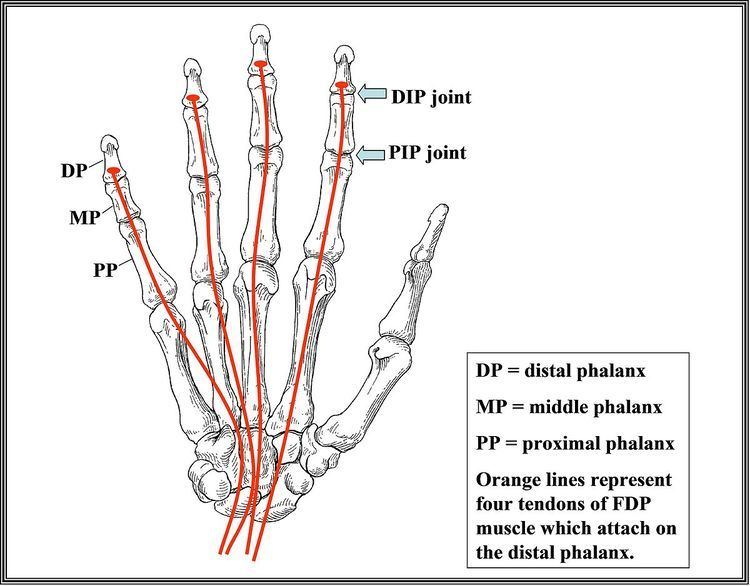 | ||
The Jersey Finger is a finger-related tendon injury that is common in athletics and can result in permanent loss of flexion of the end of the finger if not surgically repaired. This injury often occurs in American football when a player grabs another player's jersey with the tips of one or more fingers while that player is pulling or running away.
Contents
Anatomy
All four non-thumb digits (index finger, middle finger, ring finger and little finger) contain three bones called the phalanges that are aligned in a linear row like box cars in a train. These bones are designated the proximal phalanx (closest to the palm), the middle phalanx and the distal phalanx (farthest from the palm). The joints between these bones are referred to as the proximal interphalangeal joint (PIP, between the proximal and middle phalanx) and the distal interphalangeal joint (DIP, between the middle and distal phalanx). Large muscles in the forearm send long tendons to the fingers and these tendons attach at specific points on these bones. Flexing and extending these digits occurs when these muscles contract and their tendons pull on their bony attachments. The deepest of the flexor muscles in the anterior forearm is called the flexor digitorum profundus muscle (FDP); it gives off four tendons that travel through the carpal tunnel into the hand and attach to the distal phalanx in each of the four non-thumb digits.
Jersey Finger Injury
A Jersey finger is an injury to an FDP tendon at its point of attachment to the distal phalanx. This injury often occurs in American football when a player grabs another player's jersey with the tips of one or more fingers while that player is pulling or running away. The force of this action hyperextends the tip of the finger at the DIP joint while the proximal portion of the finger is flexed. This action can partially or completely rupture the FDP tendon at or near its attachment point on the distal phalanx. Sometimes, the force is great enough to pull off or avulse a piece of phalangeal bone to which the tendon can remain attached. The torn FDP tendon can retract slightly, remaining in the finger near the PIP joint, or can retract more fully into the palm of the hand. A person who suffers a jersey finger injury in which the FDP tendon is completely ruptured cannot flex the affected digit at the DIP joint without assistance.
Symptoms include:
Treatment
The classically used Leddy and Packer Classification breaks Jersey finger tendon injuries up based on the degree of tendon injury, retraction, and presence of a concomitant fracture.
Often, surgical pins are inserted into the injured digit to stabilize the bone and tendon in their proper alignment. Post surgical complications can include infection, pin failure and nail and joint deformity.
